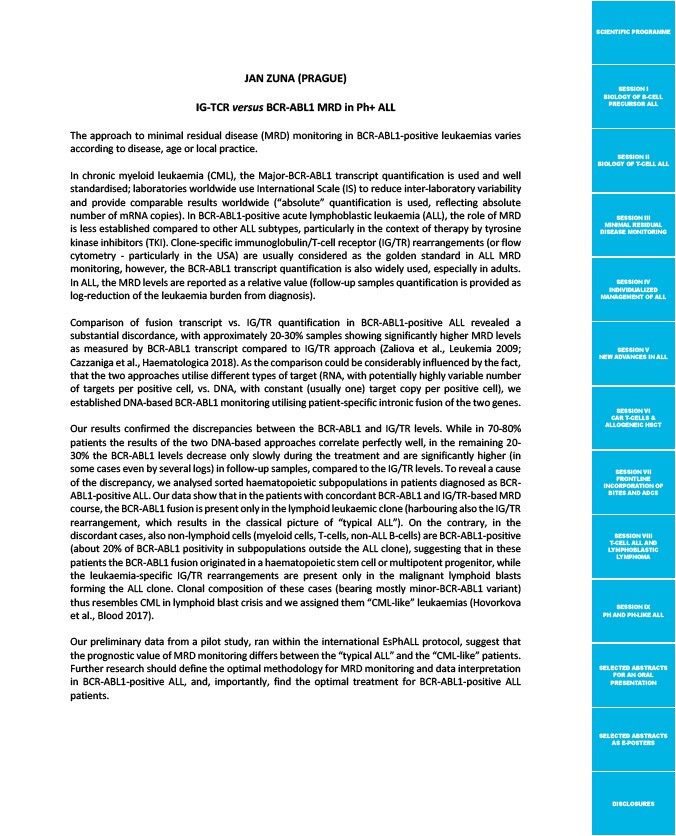
SCIENTIFIC PROGRAMME
SESSION I
BIOLOGY OF B-CELL
PRECURSOR ALL
SESSION II
BIOLOGY OF T-CELL ALL
SESSION III
MINIMAL RESIDUAL
DISEASE MONITORING
SESSION IV
INDIVIDUALIZED
MANAGEMENT OF ALL
SESSION V
NEW ADVANCES IN ALL
SESSION VI
CAR T-CELLS &
ALLOGENEIC HSCT
SESSION VII
FRONTLINE
INCORPORATION OF
BITES AND ADCS
SESSION VIII
T-CELL ALL AND
LYMPHOBLASTIC
LYMPHOMA
SESSION IX
PH AND PH-LIKE ALL
SELECTED ABSTRACTS
FOR AN ORAL
PRESENTATION
SELECTED ABSTRACTS
AS E-POSTERS
DISCLOSURES
JAN ZUNA (PRAGUE)
IG-TCR versus BCR-ABL1 MRD in Ph+ ALL
The approach to minimal residual disease (MRD) monitoring in BCR-ABL1-positive leukaemias varies
according to disease, age or local practice.
In chronic myeloid leukaemia (CML), the Major-BCR-ABL1 transcript quantification is used and well
standardised; laboratories worldwide use International Scale (IS) to reduce inter-laboratory variability
and provide comparable results worldwide (“absolute” quantification is used, reflecting absolute
number of mRNA copies). In BCR-ABL1-positive acute lymphoblastic leukaemia (ALL), the role of MRD
is less established compared to other ALL subtypes, particularly in the context of therapy by tyrosine
kinase inhibitors (TKI). Clone-specific immunoglobulin/T-cell receptor (IG/TR) rearrangements (or flow
cytometry - particularly in the USA) are usually considered as the golden standard in ALL MRD
monitoring, however, the BCR-ABL1 transcript quantification is also widely used, especially in adults.
In ALL, the MRD levels are reported as a relative value (follow-up samples quantification is provided as
log-reduction of the leukaemia burden from diagnosis).
Comparison of fusion transcript vs. IG/TR quantification in BCR-ABL1-positive ALL revealed a
substantial discordance, with approximately 20-30% samples showing significantly higher MRD levels
as measured by BCR-ABL1 transcript compared to IG/TR approach (Zaliova et al., Leukemia 2009;
Cazzaniga et al., Haematologica 2018). As the comparison could be considerably influenced by the fact,
that the two approaches utilise different types of target (RNA, with potentially highly variable number
of targets per positive cell, vs. DNA, with constant (usually one) target copy per positive cell), we
established DNA-based BCR-ABL1 monitoring utilising patient-specific intronic fusion of the two genes.
Our results confirmed the discrepancies between the BCR-ABL1 and IG/TR levels. While in 70-80%
patients the results of the two DNA-based approaches correlate perfectly well, in the remaining 20-
30% the BCR-ABL1 levels decrease only slowly during the treatment and are significantly higher (in
some cases even by several logs) in follow-up samples, compared to the IG/TR levels. To reveal a cause
of the discrepancy, we analysed sorted haematopoietic subpopulations in patients diagnosed as BCR-ABL1-
positive ALL. Our data show that in the patients with concordant BCR-ABL1 and IG/TR-based MRD
course, the BCR-ABL1 fusion is present only in the lymphoid leukaemic clone (harbouring also the IG/TR
rearrangement, which results in the classical picture of “typical ALL”). On the contrary, in the
discordant cases, also non-lymphoid cells (myeloid cells, T-cells, non-ALL B-cells) are BCR-ABL1-positive
(about 20% of BCR-ABL1 positivity in subpopulations outside the ALL clone), suggesting that in these
patients the BCR-ABL1 fusion originated in a haematopoietic stem cell or multipotent progenitor, while
the leukaemia-specific IG/TR rearrangements are present only in the malignant lymphoid blasts
forming the ALL clone. Clonal composition of these cases (bearing mostly minor-BCR-ABL1 variant)
thus resembles CML in lymphoid blast crisis and we assigned them “CML-like” leukaemias (Hovorkova
et al., Blood 2017).
Our preliminary data from a pilot study, ran within the international EsPhALL protocol, suggest that
the prognostic value of MRD monitoring differs between the “typical ALL” and the “CML-like” patients.
Further research should define the optimal methodology for MRD monitoring and data interpretation
in BCR-ABL1-positive ALL, and, importantly, find the optimal treatment for BCR-ABL1-positive ALL
patients.